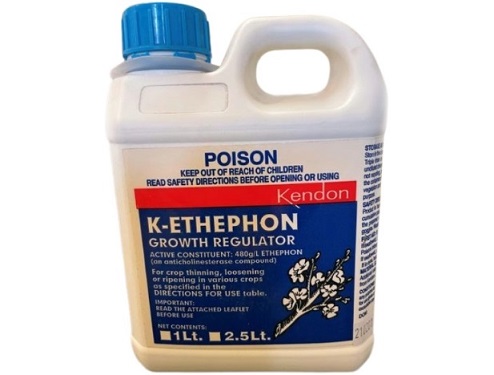Thailand Doctors Provide New Insights into Ethephon Poisoning Including Clinical Characteristics and Patient Outcomes
Nikhil Prasad Fact checked by:Thailand Medical News Team Feb 08, 2025 8 months, 3 weeks, 51 minutes ago
Thailand Doctors: Ethephon is a widely used plant growth regulator that helps in fruit ripening, flower induction, and other agricultural applications. While its use in farming is common, concerns about its toxicity and impact on human health remain largely understudied. A recent research study conducted by
Thailand Doctors from the Department of Emergency Medicine and the Ramathibodi Poison Center at Mahidol University, Thailand, sheds new light on the clinical characteristics, treatment, and outcomes of individuals exposed to ethephon-containing products.
 Thailand Doctors Provide New Insights into Ethephon Poisoning Including Clinical Characteristics and Patient Outcomes
Thailand Doctors Provide New Insights into Ethephon Poisoning Including Clinical Characteristics and Patient Outcomes
The study analyzed cases from 2013 to 2020, covering a total of 252 patients who were exposed to ethephon. The primary goal was to assess the severity of poisoning, treatment strategies, and patient outcomes. This Medical News report provides a detailed summary of the key findings from the study, helping the public better understand the potential dangers of ethephon exposure.
Key Findings from The Study
One of the most significant observations from the study was that a majority of patients (65.9%) were male, with a median age of 32 years. Nearly all cases of exposure (98.8%) were through ingestion, with only a small number of cases resulting from inhalation. Interestingly, 83.3% of cases were unintentional, while 16.7% resulted from deliberate ingestion, possibly in suicide attempts.
Upon hospital admission, patients presented a variety of symptoms. The most commonly observed effects were gastrointestinal (GI) symptoms, reported in 55.6% of cases. These included nausea, vomiting, abdominal pain, diarrhea, and hypersalivation. Localized irritation in the mouth and throat was observed in 35.3% of cases, while neurological symptoms such as dizziness and drowsiness were reported in 9.1% of cases. Respiratory symptoms, such as difficulty breathing, were rare, occurring in only 1.6% of cases.
Hospitalization And Treatment Outcomes
A significant portion of the patients (42.9%) required hospital admission, with an average stay of two days. Most cases were mild and required only supportive care. However, some patients exhibited more severe symptoms that required medical interventions. Seven patients needed inotropic drugs to stabilize blood pressure, while six required intubation and ventilator support.
Despite the generally low mortality rate, two patients died as a result of complications from poisoning. One of the fatalities involved a 40-year-old man with a history of alcohol dependence who ingested an unknown quantity of ethephon. He developed severe neurological and respiratory symptoms, including bradycardia and loss of consciousness. Despite medical intervention, he succumbed to complications, including pneumonia and gastrointestinal bleeding.
The second fatality was an 80-year-old man with preexisting hypertension and coronary artery disease. He accidentally ingested 25 milliliters of ethephon and initially showed no symptoms. However, he later developed severe diarrhea, respiratory distress, and
pneumonia. After ten days of hospitalization, he died from complications of septic shock.
Risk Factors for Severe Outcomes
The study identified key factors that increased the likelihood of severe or fatal outcomes. Older age, intentional ingestion, and the presence of neurological symptoms at admission were all found to be strong predictors of poor prognosis. Patients exhibiting these risk factors required closer monitoring and intensive medical care to prevent deterioration.
Another important finding was that, despite being classified as a cholinesterase inhibitor, ethephon poisoning did not consistently present with symptoms typical of cholinergic toxicity. This contradicts previous assumptions that exposure to ethephon would produce symptoms similar to those of other organophosphate poisons, such as excessive salivation, muscle weakness, and convulsions.
Implications For Public Health and Prevention
Given that a large proportion of ethephon poisoning cases were accidental, preventive measures should be implemented to reduce exposure risks. This includes better labeling of ethephon-containing products, ensuring they are stored in secure locations away from food containers, and raising public awareness about the potential dangers of ingestion. Additionally, individuals working in agricultural settings should be educated on safe handling practices to prevent accidental inhalation or skin exposure.
Medical professionals should also be aware of the signs of ethephon poisoning and its potential complications, especially in cases of deliberate ingestion. Close monitoring of high-risk patients can help improve survival rates and reduce long-term complications.
Conclusion
The findings from this study provide valuable insights into the clinical manifestations, treatment, and outcomes of ethephon poisoning. While most cases result in mild symptoms, severe cases can lead to life-threatening complications, particularly in older patients and those with preexisting conditions. The study highlights the need for improved safety measures and awareness to prevent accidental poisoning. Furthermore, healthcare professionals must remain vigilant in identifying high-risk cases to ensure timely and effective medical intervention.
The study findings were published in the peer-reviewed journal: Toxics.
https://www.mdpi.com/2305-6304/13/2/115
For the latest on
Thailand Doctors, keep on logging to Thailand Medical News.
Read Also:
https://www.thailandmedical.news/news/thailand-medical-study-shows-mung-bean-protein-improves-cardiovascular-health-in-middle-aged-adults
https://www.thailandmedical.news/news/thailand-doctors-and-pharmacists-develop-potent-antiviral-formula-against-sars-cov-2-and-influenza-viruses
https://www.thailandmedical.news/news/thailand-medical-study-finds-that-herbal-extracts-from-blue-trumpet-vine-and-ginger-can-protect-against-air-pollution
